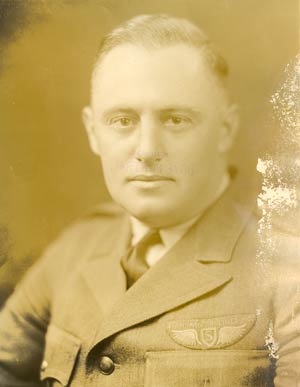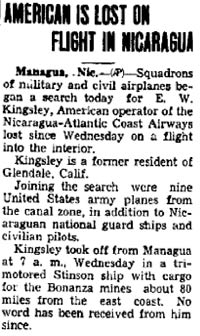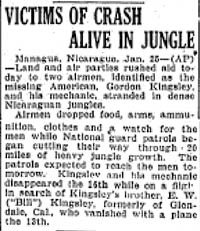|
William Kingsley was a frequent and highly regular visitor to the Davis-Monthan Airfield. He signed the Register 31 times between Saturday, February 23, 1929 and Saturday, April 27, 1929. That averages to about one landing every two days. If you examine his 31 landings, (follow the link and select Kingsley from the drop-down menu) you'll discover that he was also very punctual. Nearly all his landings were at or between 11:30AM and 2:30PM. The punctuality with which he kept his schedule in 1929 would be the envy of airlines today.
William Kingsley, Ca. 1929 (Source: Webmaster)
 |
The reason for his regularity is that he was a pilot for Standard Air Lines (SAL), one of the early pioneering lines of the southwestern U.S. Based at Los Angeles, CA, he flew the SAL route from Los Angeles through Phoenix, AZ, Tucson and El Paso, TX and return. All of his 31 landings cite these cities as places of origin and destination. Kingsley, right, wears his SAL uniform. Another photograph of Kingsley among his peers at SAL is at the link.
Kingsley flew exclusively through Tucson two of the Fokker Super Universals that were part of the SAL stable. They were NC8011 (12 visits) and NC9724 (19 visits). Please direct your browser to their links to see photographs and to learn of their use by SAL, their chains of custody and their ultimate fates. These airplanes were the workhorses of the era. Kingsley carried a total of 98 unidentified passengers across his 31 flights. Please download the SAL article linked above to review a rough analysis of the airline's business efficiency.
There are many relevant links on this site for SAL and its people. The founders of the line, pilots Jack Frye, Paul Richter and passenger Walter Hamilton, signed the Register. Pilots of the line, besides Kingsley, who also signed the Register were Lee Willey, Johnnie Martin, Harold Kelsey and Harold "Hap" Russell. All practiced the same regularity and punctuality between Los Angeles and El Paso as did Kingsley.
Air Mail Anniversary, Unsourced News Article, 1931 (Source: Woodling)
 |
Kingsley signed the Register "Wm. Kingsley." His actual name is Earl Willet Kingsley, Jr., but he was known as Bill or William. The 1920 U.S. census lists his occupation as auto mechanic. The 1930 census lists an Earl Kingsley with the occupation "aviator, Standard Airlines."
After Standard Air Lines was taken over by Western Air Express, Kingsley worked for American Airways for a short time. If you follow the link to Hap Russell, above, you'll see that he, too, flew for American Airways/Airlines and remained with the company, with seniority number 11, for a career spanning 35 years.
The 1931 news article, left, documents a flight that Kingsley made to Tucson in celebration of the 20th anniversary of the first airmail flown in the U.S. Kingsley flew the mail carrying airplane, an American Airways trimotor (probably a Fokker), but there is no evidence he signed the Register in 1931.
After American, Kingsley moved to Central America and flew for a Nicaraguan airline named Nicaragua Atlantic Coast Airways (NACA). News reports say he "operated" the line, but it was owned by a Thomas Patrick Fitzgerald, a banana plantation owner who was killed in 1936 in Nicaragua.
Ironically, Kingsley was lost in the jungle on a flight in Nicaragua in January, 1937. Below, an announcement of his disappearance.
E.W. Kingsley Lost on Flight, Unsourced News Article, January, 1937 (Source: Woodling)
 |
U.S. Army planes from the Canal Zone also joined in the search. Below, an article documenting the recruitment of Army flyers for the search and rescue attempt.
Air Corp Flyers Help in Search & Rescue, Unsourced News Article, January, 1937 (Source: Woodling)
 |
His brothers, Gordon Beach Kingsley and Edwin Marvin Kingsley (both worked with their brother in operating the NACA airline) began their own search by air. Gordon's plane experienced engine trouble and he, too, was forced to land in the jungle. He was rescued 21 days later, as described in the following, right, unsourced article from January 25, 1937.
Unsourced News Article, Gordon Kingsley Rescued, January, 1937 (Source: Woodling)
 |
Regarding our pilot, an article of January 16 stated, "The searchers were on the watch particularly for smoke signals, since Mr. Kingsley and other pilots flying over Nicaragua's mountains and jungles had an agreement that if any of them grounded in the interior they would build big smoke fires. No such signals were seen." Further, the Army pilots reported their search efforts were compromised because thick, heavy clouds hung over the section where Kingsley was believed to have disappeared.
Unsourced News Article, Kingsley Artifacts Found, April, 1948 (Source: Woodling)
 |
A month went by and the search continued, with Kingsley's brothers declaring in an article from February 20th that, "... they will not give up the hunt until they find their missing brother dead or alive."
Rumors abounded. At least one article from November 25, 1937 reported that bandits shot down Kingsley's airplane, killing all aboard. The witness reporting the event was a boy of 11 years.
Alas, regardless of how Kingsley's airplane met its fate, finding him was not to be. The wreckage of his plane (reported to be a Stinson Trimotor) was not found until April, 1948. Although his airplane, along with a ring and pistol belonging to him were reported found by the news article at left, no trace of E.W. Kingsley was ever discovered.
Earl Willet "Bill" Kingsley, Jr. was born July 7, 1898 in Los Angeles, CA, the first son of three to Georgia Evalyn Johnson and Earl Willet Kingsley. He is assumed to have died February 13, 1937 in Nicaragua.
---o0o---
Dossier: 2.1.201
THIS PAGE UPLOADED: 04/19/12 REVISED:
|







